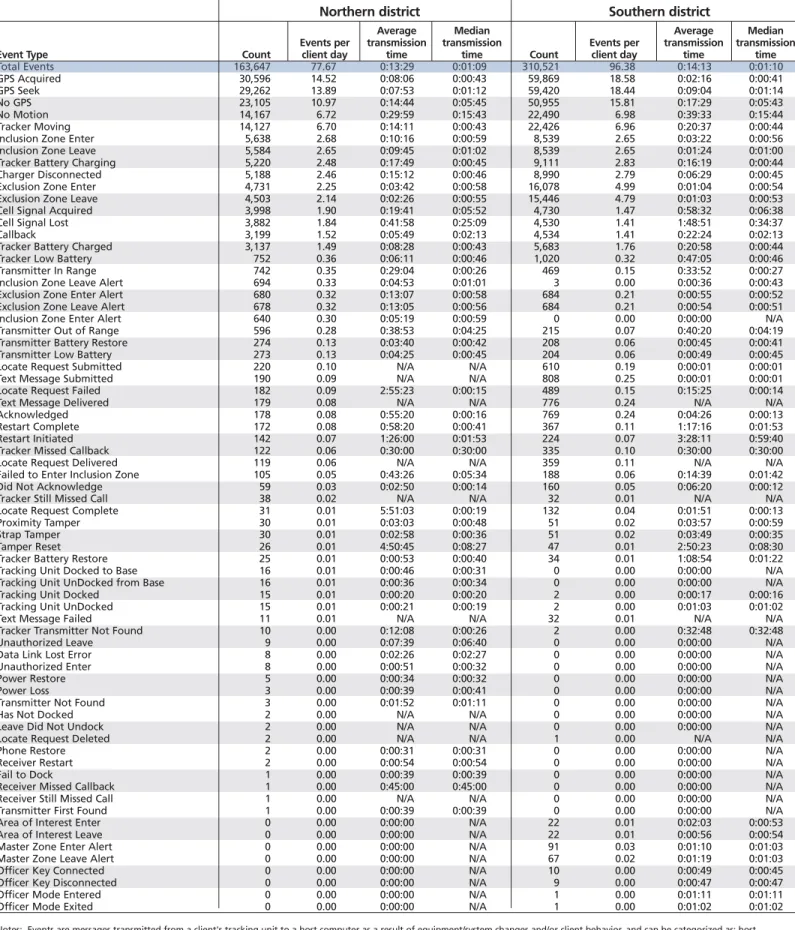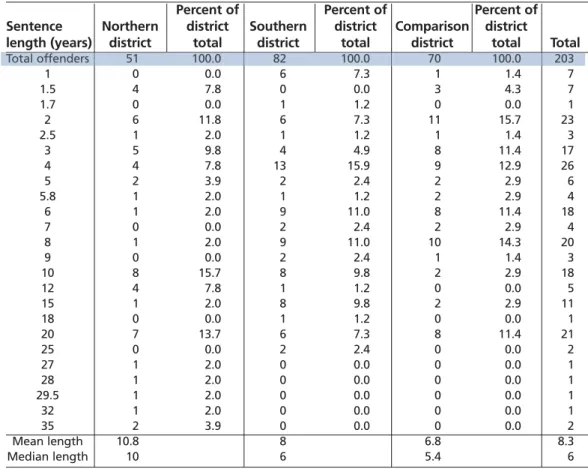The local administration of the GPS monitoring system would benefit from the personal knowledge of. Available data indicate that the dedicated staff approach used in the southern district produced more attentive operation of the GPS system. By the last date for data collection, very few (8 out of 133) of the individuals monitored with the GPS system had been arrested.
PROGRAM ORIGIN, INITIAL
The inclusion zones (places where the parolee is supposed to be at certain times, such as home or work) and exclusion zones (places where the parolee is not supposed to be, such as school) that the GPS system is supposed to monitor is determined by the parole officer in consultation with the institution community staff. Parole agents relied on community corrections staff to monitor and address alerts generated by the GPS system. These meetings were reported to focus on the operational aspects of how to "make it work". Content focused on defining exclusion zones, determining inclusion zones, and which GPS alerts should merit notification to a parole agent.
GPS EQUIPMENT
Although it is not clear why, the system in the southern district recorded almost 50 percent more GPS signal loss per customer day. Elsewhere in the report we look at the number of alerts and the time it takes to resolve these events. All that was required was adequate training from the vendor in the operational aspects of the GPS system and sufficient personnel to operate the system.
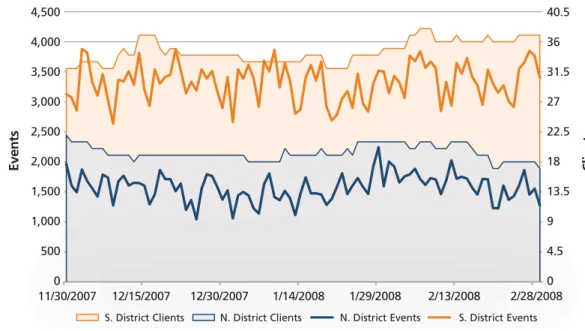
LEARNING CURVE AND
Agency personnel must develop the technical expertise to operate the system and the organizational capacity to monitor and respond to information generated by the system at all times. At the time of initiation, neither country operated a GPS monitoring system, but both were in the process of investigating such systems, and both had existing electronic RF monitoring programs using equipment from the selected GPS vendor. Therefore, the agencies had the organizational capacity and experience to operate the system; this carried with it some technical expertise in the operation of the system.
As a rough indicator of the amount of information generated by the system, the research team recorded the number of alerts at the two pilot sites twice daily (morning and evening) for a period of one week. This table indicates that the number of warnings per client varied considerably between the two sites. The southern district recorded an average of 5.53 alarms per client in the 24 hours preceding the report, while the Northern District recorded an average of 28.70 alarms per client in the previous 24-hour period.
Similarly, for the South district, the average number of open alerts per client was 0.16, while the average number of open alerts per client in the North district was 6.06. For example, the North district received significantly more reports per client, which translated into more open reports and more clients with open reports. Because an employee had to manually clear each alert, these are. organizational differences could easily explain the differences in the number of open alerts per customer.
Field observations suggested that organizational differences meant that the system was more closely monitored with full-time staff and staff were more likely to send a text message to the customer about an alarm.
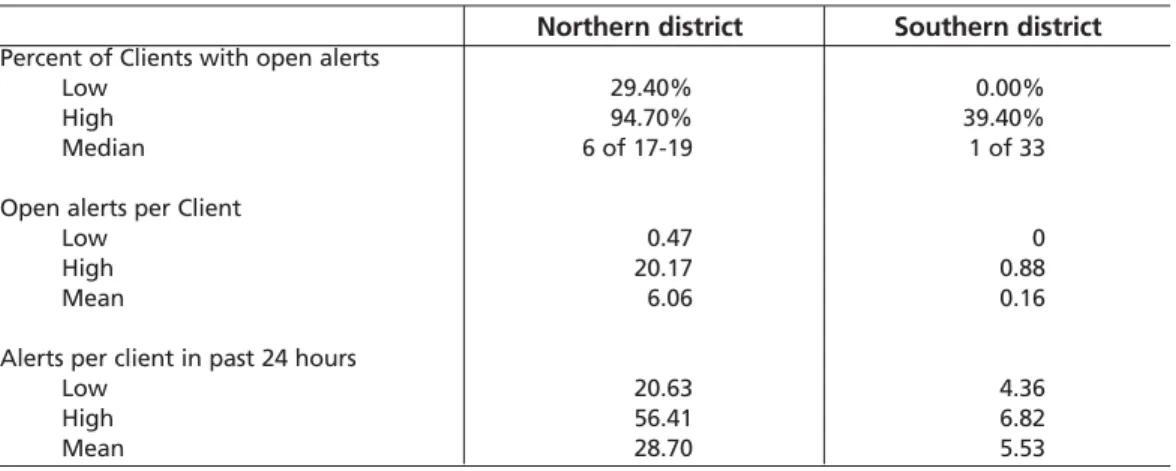
AGENCY- RELATED
The two pilot sites also differed in how they removed alerts from the system. In the Northern District, the system's linked alerts saved time for agency staff on other duties. The two pilot locations also differed in the time elapsed before an alarm was cleared.
The overall average clearing time for these alerts was 47 minutes in the northern district and 17 minutes in the southern district. On the other GPS site, 10.5 percent (6) of eligible clients had their parole revoked due to a new arrest. This was very similar to the 8.5 percent (4) dropped for a new arrest in the comparison county.
In the Northern District, more than half (56.7 percent) of GPS clients with the opportunity to participate in the program for at least six months were returned to prison for violating conditions of release. In the Southern District, only a third (33.3 percent) of GPS clients were returned to prison for violating parole conditions. A total of 56.7 percent (17) of clients in the Northern District with a potential exposure period of at least six months were returned to jail for a new arrest or a technical parole violation.
This rate was significantly lower in the southern district (43.9 percent) and slightly higher in the comparison country (61.7 percent).
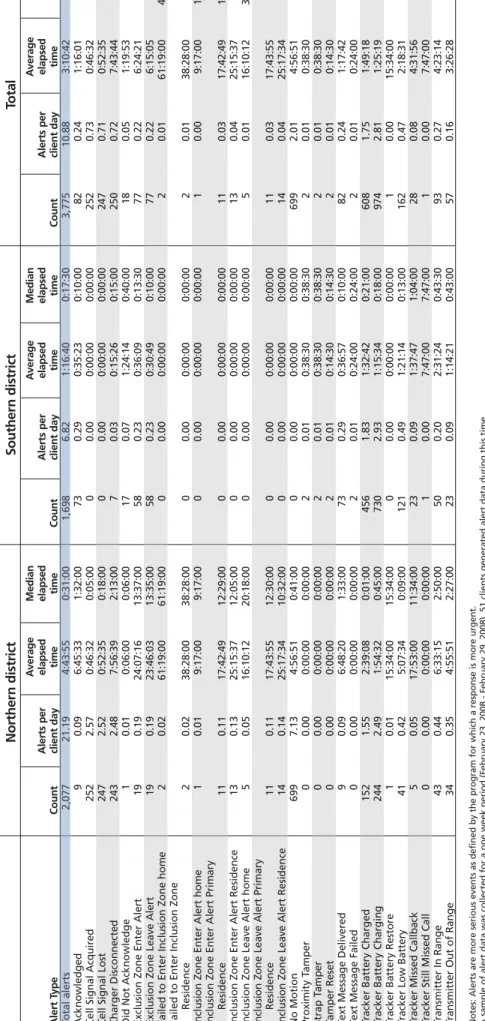
PAROLEE PERFORMANCE
An important question for the pilot program concerned the performance of individuals placed on GPS monitoring. Specifically, the research team identified the percentage of GPS Pilot Program clients with the potential for at least six months of post-incarceration experience who returned to prison for either a new arrest or a parole violation. A comparison group of paroled sex offenders was selected from another parole district in a manner that was similar to how GPS clients were selected (see Appendix 3 for research methods).
Many of the clients included in this table were still on parole at the time of data collection. This table shows that the northern district reported that none of the 30 GPS clients were removed from parole due to a new arrest. This table also shows the number of clients removed from parole due to violation of parole conditions.
These combined results indicate that the GPS pilot sites experienced lower new arrest (6.9 percent; 8.5 percent), technical violation (41.4 percent; 48.9 percent), and overall failure rates (48.3 percent; 61.7 percent) than the comparison site. The data suggests that the clients in the GPS pilot program may have had a reduced chance of returning to prison. Overall, as of the cutoff date for the assessment, eight of the 133 GPS clients were removed from the pilot program for a new arrest.
Of the remaining six individuals, two were arrested for controlled substance offenses, two were arrested for battery, one was arrested for burglary of a business, and one was arrested for a traffic violation.

PAROLE AGENT REACTIONS
Although they were happy to have the added capability and most of the GPS work was handled by the community corrections agency staff, the program required additional time. The additional workload was reported to be primarily dealing with after-hours telephone calls about clients. To counter this, the community corrections staff were in regular contact with the clients, both through text messages and through in-person meetings.
Parole officers indicated that they were very satisfied with the organizational arrangements of the program. Agents at both pilot sites commented that there was "no way" their office could have operated the GPS system.
CONCLUSION AND RECOMMENDATIONS
This largely resulted from differing views on the program rules and the role of the community corrections agency. Staff at both locations were satisfied with their version of the program, but it appears there were some significant differences. Field observation of the sites and GPS system data suggest that staff at this site dealt with each alert as it came in and often used the system's SMS feature to notify customers of the actions required of them were to lift a warning.
It is possible that the tighter operation of the system resulted in fewer violations of parole conditions. Although this finding was promising, the post-factional nature of the design allows for two other possible explanations. The first relates to the nature of the clients assigned to the program in this district: in general, participants in the northern district were identified as lower-risk offenders.
At one of the sites, the community corrections case managers also met regularly with the parolees. In the case of a pilot program where the goal is to determine "what works," the absence of direction may allow the implementing agencies to develop important adaptations. The decisions that affect the quality of the evaluation are almost always made at the design and development stage.
The assessment design does not allow identifying the reasons for this low arrest rate, but the possibility that the GPS monitoring contributed should be explored.
OPERATION OF GPS SYSTEMS
The Wide Area Augmentation System (WASS) is a system used by the Federal Aviation Administration (FAA) to improve GPS-assisted air navigation in the United States. The addition of the server helps overcome some of the problems with conventional GPS, such as multipath errors and satellite locating errors, ephemeris delay (Wikipedia, 2008d). Whether guiding missiles or simply navigating to the nearest restaurant, GPS technology can be a useful and effective tool.
A final advantage is that GPS technology is relatively easy to learn and requires little knowledge of the overall system (Garmin Inc., 2000). In the context of community supervision of offenders, Brown, McCabe and Wellford (2007) highlight the current lack of standards among community supervision programs stating that no national standards have been created for the use of GPS in these types of programs. This involves the issue of whether the use of GPS in community surveillance meets the standards and expectations set by the agency or other organizations; these questions go to the integrity of the program.
This requires that, from the beginning of the use of GPS in community monitoring, there are clear statements about how the program should work and ways to monitor whether these standards or expectations are being met (Brown et al., 2007, p. 5 -1). . In addition to inherent flaws in the system, many recent uses of GPS have raised important ethical and standards issues for GPS use. More recently, however, GPS has been used to track individuals—including paroled offenders participating in community supervision programs.
Although GPS can be a useful tool in tracking and monitoring people, expectations about how this application should work have outstripped the rush to implement GPS in these settings, and many ethical and standards-related questions remain. no answer.
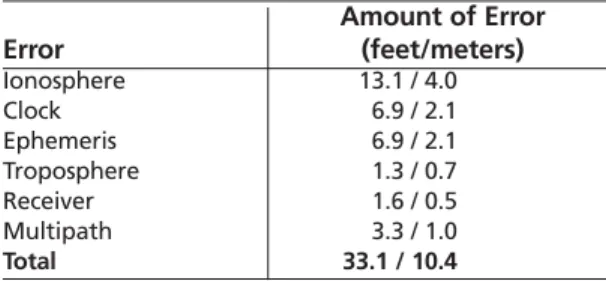
LITERATURE REVIEW
INDIANA CONDITIONAL PAROLE
SEX OFFENDERS
Report on safety issues raised by living arrangements for and location of sex offenders in the community.
